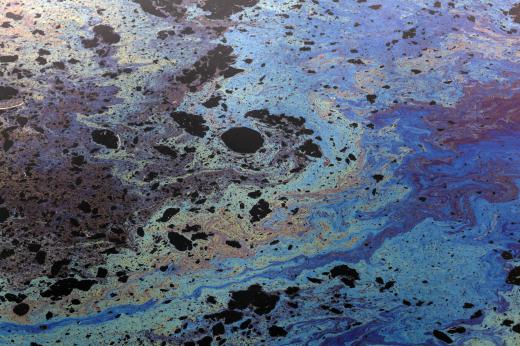What is Activated Clay?
 Mary McMahon
Mary McMahon
Activated clay is clay, usually of bentonite origin, which has been treated to improve its ability to adsorb. The clay is processed with acid, upping the adsorption properties of the clay considerably. Once it has been treated, activated clay can also be reactivated as it is used, allowing people to reuse the clay rather than having to continually replace it. There are a number of uses for this product, and it can be found directly through manufacturers and at locations like home supply stores and stores which stock auto repair supplies.
When activated clay is spread across a surface, it readily adsorbs oils and other materials present on the surface. One use for this product is in auto shops and similar repair facilities where oil often ends up on the ground; activated clay can be used to soak it up so that it can be safely removed. This product is also used in environmental cleanup of oil spills and other incidents, and in other settings where oils may accumulate, as for example in slaughterhouses where fat and grease can build up.

This product can be reactivated by heating it to get it to release the substances it has adsorbed, allowing people to reuse it. Since activated clay is sometimes used with materials which are toxic or dangerous, it is important to make sure that it is reactivated by someone with experience; one wants to avoid releasing the materials so carefully cleaned up with the assistance of the clay. People can also discard this product by securely bagging it and depositing it in waste containers which are designed to accommodate the types of materials picked up by the clay.
Companies may also refer to this product as “bleaching clay,” referencing the fact that it can bleach out pigments. Bleaching clay is used in materials processing in a variety of industries to pull out pigments, as seen for example in paper processing. It can also be used to purify and refine oils by pulling out impurities and pigments and leaving the clean oil behind.
When not in use, activated clay should be stored in a cool, dry place. If the clay is exposed to moisture it can pick it up, and in warm environments, the clay will release fluids, and it can become messy. Some people store it in sealed tubs to keep moisture out of the activated clay while it is not in use.
AS FEATURED ON:
AS FEATURED ON:











Discussion Comments
I think they used this kind of clay in cleaning up the big oil spill that happened in 2010 in the Gulf of Mexico.
I have also heard it suggested that a clay similar to this, although I'm not sure if it is acid activated clay, should be taken internally, because it "draws out the toxins".
I once read that Ancient Romans used to eat clay pills to prevent poisoning, and it's true certain kinds of clay will stick to heavy metals and can help in that way.
But I think most of the time the clay being sold to "absorb toxins" is just another sugar pill, and one which could be harmful. Clay could cause a bowel obstruction, after all.
So, if you plan to take some clay, ask your doctor about it first and see what they say.
I first read this and thought it said "absorb" which didn't make sense to me, because I know one of the properties of clay that makes it such a bad gardening soil if you have too much of it, is that it doesn't absorb water very well. '
But then I saw it was "adsorb" which apparently means to hold a substance in a thin film on the outer surface.
So, the activated bleaching clay doesn't really soak in the liquids, it pulls them more like a magnet, to sit on its surface.
That really must be useful, because it would be easy to then wash the liquid off again and reuse the clay.
Post your comments